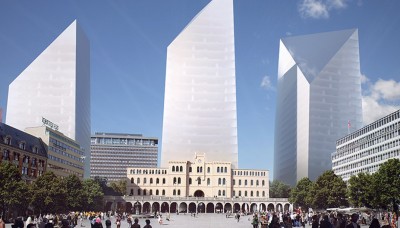The state committee charged with evaluating redevelopment proposals for Norway’s bombed government complex in downtown Oslo has advised against building the skyscrapers included in several of the plans. The committee concluded that nothing should be built higher than the one original 17-story building that will be preserved.

The lone high-rise in the area known as Høyblokken, which housed both the Justice Ministry and the Office of the Prime Minister, is now unlikely to be overshadowed by the skyscrapers proposed by several leading architects. They submitted plans earlier this year that have been been on display for public comment and evaluation by a professional committee.
It delivered its evaluation to state property and construction firm Statsbygg, and recommended that several new buildings slightly lower than Høyblokken should be built just behind it, where the ministries heavily damaged by a bombing in 2011 have stood.
The committee did recommend that the low-rise still standing next to Høyblokken, called Y-blokka, be razed as planned, with the artworks sandblasted on its walls removed and placed elsewhere in the complex. The streets running on each side of the complex should remain closed to thru-traffic, for security reasons, with a park on the complex’ existing plaza.
The committee’s recommendation seems largely in line with public sentiment after the skyscraper proposals were met with heavy criticism, also by city officials and local urban planners. “The Royal Palace and the Parliament are of moderate size,” Ellen de Vibe, head of Oslo’s planning department, wrote in a letter to Statsbygg. “It would be very strange if one powerful state institution (the government and its ministries) should have a completely over-dimensioned physical form.”
The skyscrapers would have towered over not just Høyblokken but also the Supreme Court building and the historic finance ministry building, which both survived the bombing by a right-wing extremist angry with the Labour Party-led government at the time.
The only immediate negative reaction to the committee’s evaluation from state government employees, who fear that the lack of taller buildings will reduce office space and thereby capacity to accommodate all the bureaucrats due to move back into the central location known as Regjeringskvartal, just a block from the Parliament. “If they reduce the height, there won’t be enough room for everyone,” Inger Riis-Johannessen, who represents ministerial employees, told Norwegian Broacasting (NRK).
De Vibe recommended that plans to consolidate all the ministries downtown be dropped, to relieve space pressure. Statsbygg will now use the committee’s recommendation in its own plans, due next year, for redevelopment and any rezoning that will be necessary. The goal is to have the first phase of the new complex completed by 2024.
newsinenglish.no/Nina Berglund

